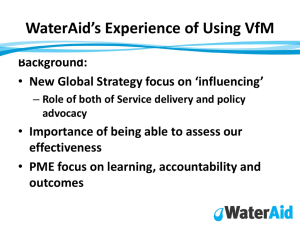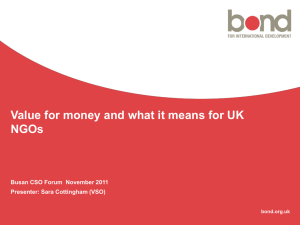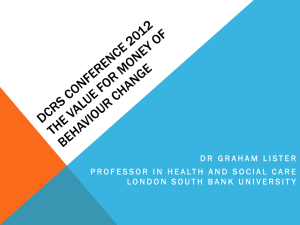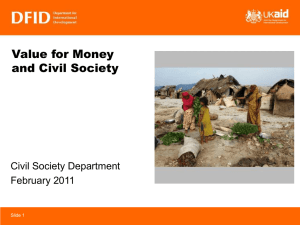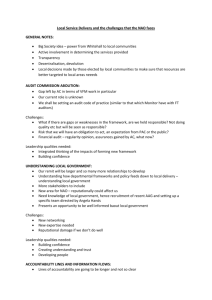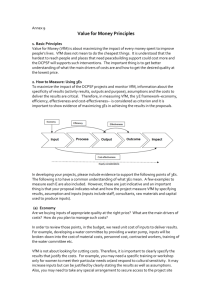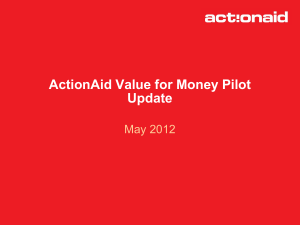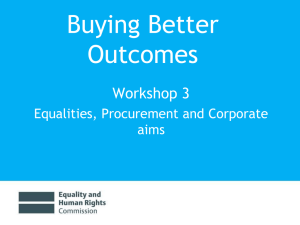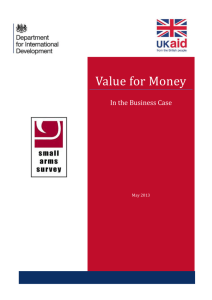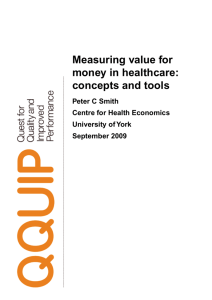What is Value for Money (VFM)? Word
advertisement
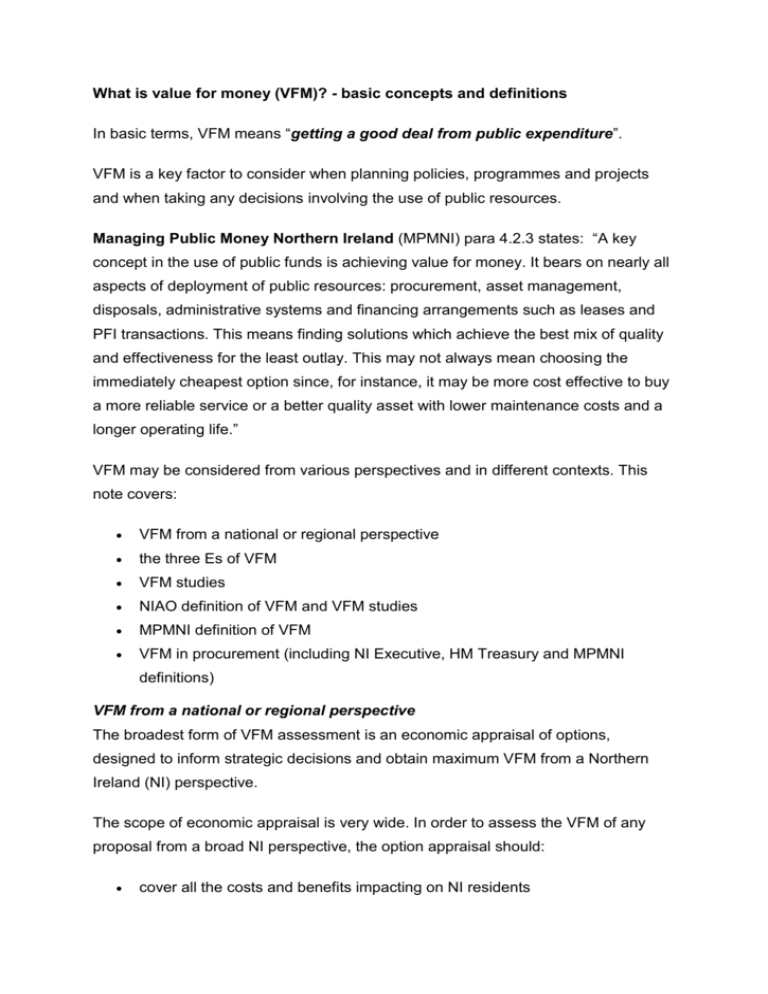
What is value for money (VFM)? - basic concepts and definitions In basic terms, VFM means “getting a good deal from public expenditure”. VFM is a key factor to consider when planning policies, programmes and projects and when taking any decisions involving the use of public resources. Managing Public Money Northern Ireland (MPMNI) para 4.2.3 states: “A key concept in the use of public funds is achieving value for money. It bears on nearly all aspects of deployment of public resources: procurement, asset management, disposals, administrative systems and financing arrangements such as leases and PFI transactions. This means finding solutions which achieve the best mix of quality and effectiveness for the least outlay. This may not always mean choosing the immediately cheapest option since, for instance, it may be more cost effective to buy a more reliable service or a better quality asset with lower maintenance costs and a longer operating life.” VFM may be considered from various perspectives and in different contexts. This note covers: VFM from a national or regional perspective the three Es of VFM VFM studies NIAO definition of VFM and VFM studies MPMNI definition of VFM VFM in procurement (including NI Executive, HM Treasury and MPMNI definitions) VFM from a national or regional perspective The broadest form of VFM assessment is an economic appraisal of options, designed to inform strategic decisions and obtain maximum VFM from a Northern Ireland (NI) perspective. The scope of economic appraisal is very wide. In order to assess the VFM of any proposal from a broad NI perspective, the option appraisal should: cover all the costs and benefits impacting on NI residents assess not only the costs and benefits falling to the public sector, but also those affecting other sectors in NI such as the private and voluntary sectors take account of the full range of impacts, including for example economic, social, environmental and distributional effects An appraisal may be designed to inform a variety of strategic decisions. For example, it may be to examine a range of policy options; or to determine the appropriate type and level of public services to provide; or to decide whether to give public assistance to a private or community sector project. In any case, it typically involves assessing needs, objectives, options, costs, benefits, risks, funding, affordability and any other factors relevant to the decision in view. When conducting a strategic economic appraisal, VFM is achieved by pursuing the option which offers the maximum net benefits to Northern Ireland when all the costs, benefits and other relevant factors are taken into account. The three Es VFM is often described and assessed in terms of “the three Es” of economy, efficiency and effectiveness; and sometimes a fourth E (for equity) is included: Economy - careful use of resources to minimise expense, time or effort. Efficiency - delivering the same level of service for minimum input of cost, time or effort; or obtaining maximum benefit from a given level of input. Effectiveness – delivering a successful outcome and meeting objectives as fully as possible. The fourth E is: Equity – delivering services and using resources in a way that is fair to all. VFM studies VFM studies can vary considerably in scale and content, ranging from large scale strategic economic appraisals which assess VFM from a national or regional perspective; to smaller scale reviews of economy, effectiveness or efficiency for particular activities. NIAO definitions of VFM and VFM studies The NIAO has stated: “Good value for money can be defined as the optimal use of resources to achieve the intended outcomes. A VFM study focuses on a specific area of government expenditure and seeks to make a judgment on how well government has managed its resources and delivered services.” (NIAO report Value For Money Standards, 10th June 2011). MPMNI definition of VFM MPMNI para 3.3.3 defines VFM as: “ensuring that the organisation’s procurement, projects and processes are systematically evaluated and assessed to provide confidence about suitability, effectiveness, prudence, quality, value and avoidance of error and other waste, judged for the public sector as a whole, not just for the Accounting Officer’s organisation.” (The MPMNI Glossary also contains a similar definition). VFM in procurement A substantial number of economic appraisals are followed by a procurement process e.g. where a capital project or a contract for service provision needs to be procured. There are specific definitions for VFM in procurement: The NI Executive (based on the advice of the NI Procurement Board) approved the following definition of best VFM in March 2011: “The most advantageous combination of cost, quality and sustainability to meet customer requirements.” In this context, cost means consideration of the whole life cost; quality means meeting a specification which is fit for purpose and sufficient to meet the customer’s requirements; and sustainability means economic, social and environmental benefits, considered in the business case, in support of the Programme for Government. HM Treasury has defined VFM in procurement as “the optimum combination of whole-of-life cost and quality (or fitness for purpose) of the good or service to meet the user’s requirement”. (Value for Money Assessment Guidance, HM Treasury November 2006, paragraph 1.10). Managing Public Money (NI) MPMNI para 4.2.3 defines VFM in procurement as “the optimum combination of whole life cost and quality (or fitness for purpose) to meet the customer’s requirements.” (Also stated at A.4.4.4) This is similar to the Managing Public Money (UK) definition.
